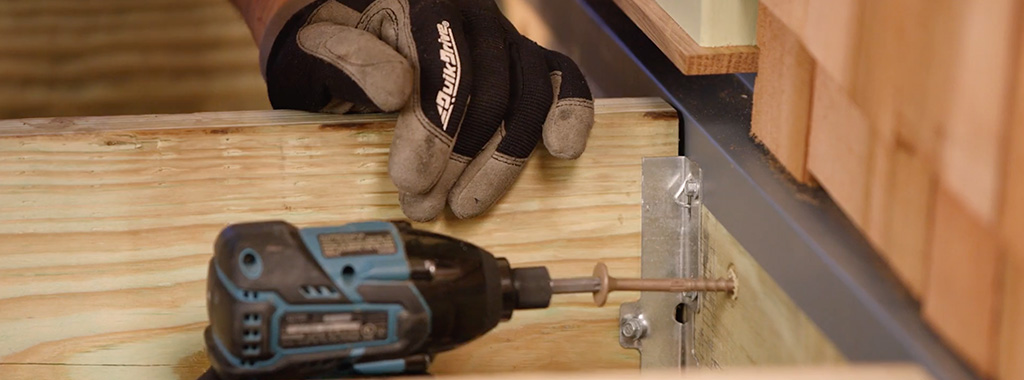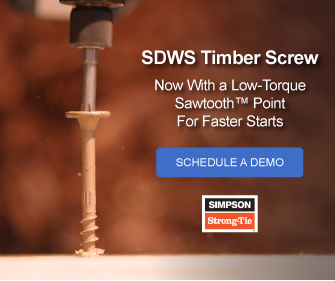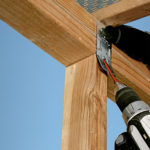Simpson Strong-Tie® R&D engineers are always looking to make products even better and more cost effective, in ways that will improve life not only for homeowners, but also for Designers and builders. In the following post, Aram Khachadourian explains how the newly designed SawTooth™ point on our code-listed Strong-Drive® SDWS Timber screw makes driving faster and easier with no predrilling. The flat head also makes connector and sheathing placement a lot smoother.
It was recently announced that the Strong-Drive SDWS Timber screw has been updated with a newly designed point. You might ask, “Well, what was wrong with the old point?” The short answer is: Nothing. But even when a product has no faults or problems, that doesn’t mean there isn’t room for improvement. Our new and improved Timber screw is the same great structural screw described in IAPMO UES ER-192, but with a new proprietary point.
It was more than twenty years ago that Simpson Strong-Tie changed the fastening world with the introduction of a heavy-duty structural connector screw that could be used in wood construction as an alternative to bolts. That screw, the SDS or Strong-Drive screw, was the first screw of its kind that could be installed without predrilling and get loads comparable to bolts. This made design less complex for engineers and construction easier for contractors. But we didn’t stop there. Over the years we’ve introduced many more structural screws, and made improvements to fastener geometry, heat treatment and coatings. We’ve developed screws to replace bolts in connectors, ledgers, pile construction and more.
The improvements have been both large and small, but all of them have been made to fulfill our mission to help people build safer structures more efficiently — saving time, money and possibly even lives.

The new patented point is called the SawTooth™ and improves SDWS performance in two key respects. The first is that it grabs the wood, helping the screw start fast and drive quickly. Occasionally, a builder runs into a piece of wood that’s harder than the others or is using engineered wood with a hard surface. When a hard surface condition is encountered, most screw points will spin around at the surface, grinding away at the wood fibers until one of the threads can finally catch and begin to cut in. We designed the SawTooth point with a sharp angle and serrated threads to penetrate the wood quickly. The threads begin to work right away, pulling the screw in faster without the frustration of waiting for the point to scrape open a hole.
The second performance enhancement we’ve made to the SDWS is to lower the driving torque. Let’s face it, some of these screws are long, and you don’t want to have to fight to keep from being thrown by the drill. The SawTooth point has a cutting knurl built into the point of the screw. This helps open a hole in the wood to receive the threaded length of the screw all while it’s being pulled in by the threads. Having a knurl at the top of the threads helps reduce friction on the shank. The result is a screw that drives with less wear and tear on the installer, the drill motor or the drill battery.
I’ll mention one other aspect of the SDWS Timber screw that’s a favorite among builders — the flat head. Construction isn’t always as simple and clean as it appears in the catalogs. Sometimes you don’t have as much room as you need to fit all the pieces together. The flat head of this screw allows structural connectors to be fitted in place right over the screws. This eliminates having to move things around. One example is a ledger fastened to the rim board with Timber screws, where joist hangers will need to be installed. The screws fastening the ledger would almost certainly interfere with the placement of the hangers if not for the flat head of the Timber screw, which lets you position the hanger right over the head of the screw. From avoiding hanger interference to allowing installers to put drywall or sheathing right on top of the screws, the flat head of the SDWS makes construction easier.
The SDWS is load rated for use in wood-to-wood and engineered wood connections, ledgers, gypsum applications and much more. It also can be used in exterior conditions and with chemically treated wood, as attested by its corrosion resistance rating in IAPMO UES ER-192. While we believe the Timber screw is in many ways the best screw available on the market today, we’ll continue to look for ways to improve it— because when it comes to screw innovation, we never know when to stop at Simpson Strong-Tie.







